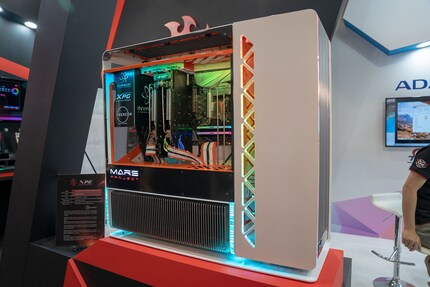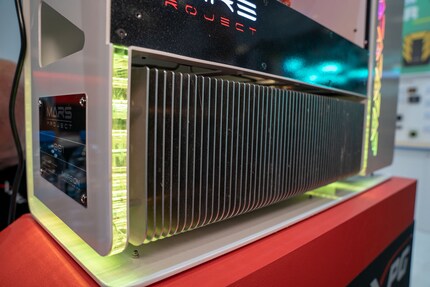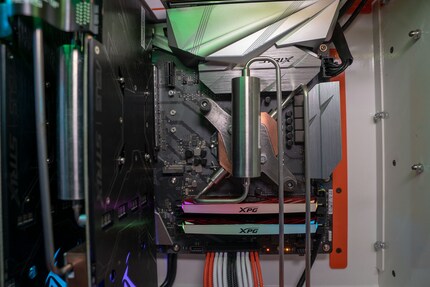Invasion Mars project: the PC that’s ready for outer space
At IFA in Berlin there’s a big white box with «Mars Project» scrawled across it in big letters. Inside the box are PC parts you’d recognise from any gamer computer. But what is almost lost in the noise of the trade show is the fact the device is silent thanks to completely passive cooling.
When you think about the noise absorption in your PC, up until now you’ve probably had two main cooling choices:
- Water cooling
- Ohropax
The second option makes sense if you don’t want to sink your expensive PC components. Invasion Laboratories have since developed a third option. It’s the 100% passively cooled gamer PC. As I type, the computer is sitting in a PC case labelled «Invasion Laboratories Project Mars» in hall 17 at Berlin’s IFA, the world’s leading trade show on consumer electronics and home appliances.

Source: Dominik Bärlocher
Technology from Soviet times
Judging by all my research, Invasion Laboratories is from Russia. But the Chinese guy who told me about the PC worked on the XPG stand and his business card had the Adata logo on it. According to this earnest young chap, Invasion Labs is XPG’s Russian partner. And in turn, XPG is the subsidiary of Adatas.

Source: Gazprom.com
Invasion labs worked with the temperature monitoring company Thercon to develop the Mars Project. In Soviet Union times, Thercon worked for the Russian space agency and then for all space agencies and companies. On their website, the company mentions the satellite series Yamal 200 that has been circling the Earth since the early noughties.
Yamal 201 and 202 were shot into space by Gazprom Space Systems in 2003 to satisfy the communication needs of the Russian gas company Gazprom. The components in the Yamal series come from PAO S. P. Korolev Rocket and Space Corporation Energia, a space agency, and Alcatel Space, which built the communications components.
Since then, Alcatel Space has changed its name to Thales Space. And Yamal 201 and 202 were successful in their mission and did what was asked of them. While Yamal 203 and 204 were commissioned, the order was subsequently cancelled before work began.
The technology that has been in development since 1972 is now used in the passively cooled Chinese-Russian PC.
A closer look at passive cooling
Thercon designed the case for the Mars Project. It’s easy to explain why they’d even do something like this. Alongside the undeniable truth that the tower is quieter than with ventilators or water cooling systems, it comes down to the fact Invasion Labs can do away with all moving parts. This makes the PC suitable for space travel.
Let’s face it, moving parts in space aren’t ideal. That’s something readers of Andy Weir’s book «The Martian» know all too well. This piece of fiction is factually accurate in current tech terms. There was even a film adaptation where Matt Damon played the fictitious astronaut Mark Watney. He is known for saying that moving parts have the annoying habit of failing at the worst possible moment. In outer space, for instance, where you’d never get a mechanic to do a call-out – and not just because it was a Sunday. If a system fails, it can cost a space agency a good few million or even the whole mission.

Source: Dominik Bärlocher
Below all the components is an aluminum grill that conducts heat from inside the machine to the outside and brings cold air from the exterior to interior. There’s another grill on the front in the same place you find the few buttons that have been built into the machine. As part of effective thermal conduction, gas is sent through thin tubes.
Here’s what happens: the grills cool the gas in the tubes. The gas then becomes a liquid and cools the components before turning back into a gas again. Finally, the gas goes back into the grill where it’s cooled and the whole process starts again.

Source: Dominik Bärlocher
The whole department came running over to see how the liquid inexplicably flowed upwards. Even we were stunned that our theory actually worked.
But it’ll be some time before the Mars Project really does fly to Mars. The guy at the stand at IFA admitted there weren’t any specific plans yet to send the PC into outer space. But their inspiration was obviously space travel and that’s why this PC is much more than just a gadget.
Journalist. Author. Hacker. A storyteller searching for boundaries, secrets and taboos – putting the world to paper. Not because I can but because I can’t not.
Interesting facts about products, behind-the-scenes looks at manufacturers and deep-dives on interesting people.
Show all